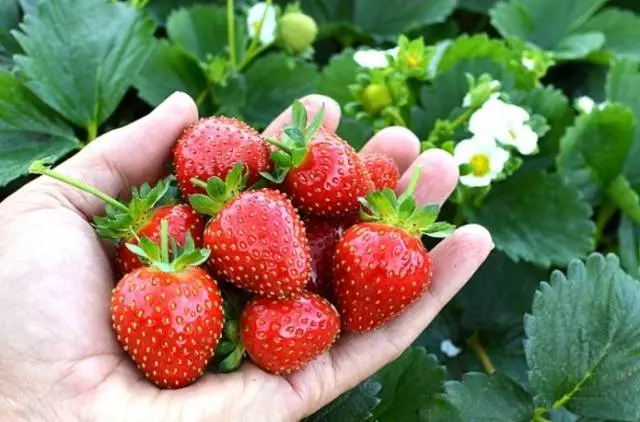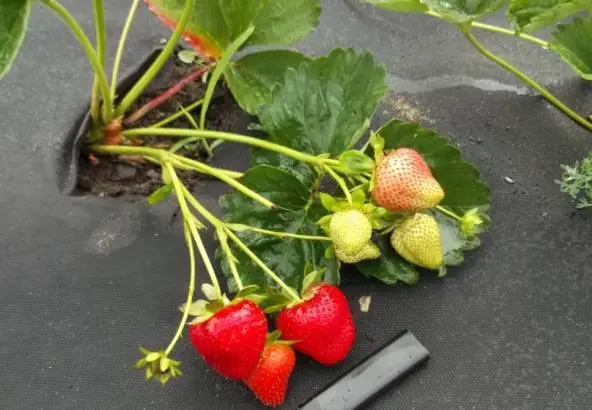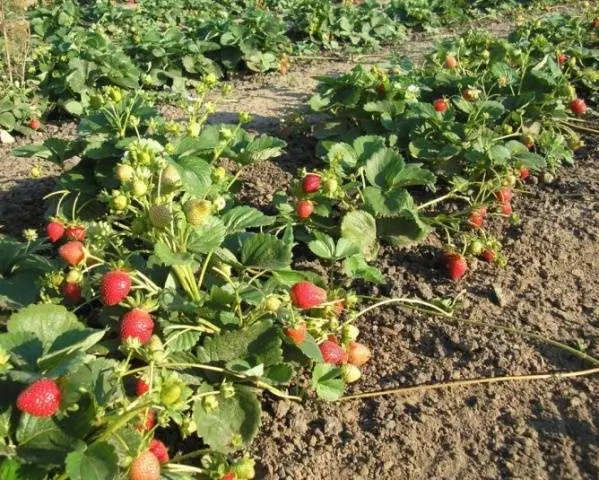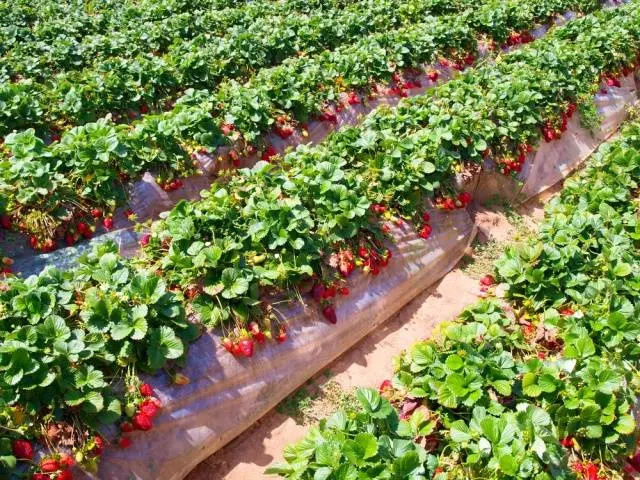A new variety of neutral daylight hours – Avis Delight strawberry, a description of the variety, photo, reviews of which indicate that the authors tried to seriously compete with the industrial varieties of remontant strawberries that are common today. Even the name of the variety is very pathetic. In the -language reading, it sounds like “Evis Delight”, in the original, the spelling of the variety can be interpreted as – Eve’s Delight, that is, “Eve’s delight”. By some parameters, in particular, by the amount of sugars in the berry, the new strawberry really surpasses the industrial varieties, which deservedly received the nickname “plastic” among the people.
However, when choosing a name for a new variety, the authors had a little fun with a play on words. On their account, you can write down not only the Evis Delight garden strawberries, but also several previously bred varieties of the EV line: Sweet Eve, Eveie and others.
The variety was obtained in 2004 in the UK from parent forms of neutral daylight hours: 02P78 x 02EVA13R. A patent for a strawberry hybrid was obtained in 2010.

Description
Large-fruited strawberry Evis Delight is a plant that can produce several crops per season. A distinctive feature of this variety of strawberries are erect flower stalks that can hold even fairly large berries on weight.
Patent description of the strawberry variety “Evis Delight”:
- large vertically growing bush 38 cm high;
- large homogeneous fruits;
- berries are mostly conical, a small part may be wedge-shaped;
- bright red color of berries;
- smooth shiny skin;
- long, upright peduncles;
- medium and late ripening berries;
- repeated fruiting for a long time.
The patent presents not only a verbal description of the Avis Delight strawberry variety, but also a photo.

Description of Evis Delight strawberry fruits:
- the ratio of length and width: the length is greater than the width;
- size: large;
- prevailing shape: cone-shaped;
- aroma: strong;
- the difference in shape between the berries of the first and second crops: from moderate to strong;
- difference in shape between the berries of the first and third harvests: moderate;
- band without achenes: narrow;
- color of ripe berries: bright red;
- color uniformity: uniform;
- skin glossiness: high;
- seed shape: uniform slight convexity;
- the position of the petals of the receptacle: uniform;
- color of the upper surface of the receptacle: green;
- color of the lower surface of the receptacle: green;
- receptacle size in relation to berry diameter: usually smaller;
- pulp firmness: moderate;
- flesh color: the inner color of the pulp at the outer edges of the surface of the fruit is closer to bright orange-red, and the inner core is closer to red;
- hollow center: moderately expressed in primary fruits, weakly expressed in secondary and tertiary berries;
- seed color: usually yellow, red when fully ripe;
- flowering time: medium to late;
- ripening time: medium to late;
- berry type: neutral light day.
Other characteristics of Eves Delight: the ability to reproduce is low, during the growing season it forms only 2 – 3 additional rosettes; frost-resistant: it can winter without problems in the regions of Moscow and in the Kamchatka Territory. The only requirement for wintering is shelter. In the Central regions of Our Country and in Ukraine, agrofabric is enough for Evis. To the north, more reliable cover will be needed.
In the patent description of strawberries, Avis Delight, the variety’s resistance to diseases such as powdery mildew, late blight and verticillosis is indicated.
Evis was created as a competitor to Albion, another common strawberry variety in the UK, so all the characteristics of Evis in the patent are given in comparison with Albion. In general, Eves Delight outperforms Albion in terms of taste and technical characteristics, but is inferior to it in terms of yield.

The yield of remontant strawberries “Evis Delight”, due to long fruiting, is up to 700 g of berries from one bush. Even when ripe, the flower stalks hold the berries above the leaves, making berry picking very convenient.
The yield of the strawberry variety Evis Delight depends on the planting density. Theoretical reaches 1,5 kg per bush. Estimated yield at a planting density of strawberry bushes of 8 pcs / m² – 900 g per bush. With a density of 4 bushes per 1 m² – 1,4 kg. The estimated average weight of one berry is 33 g.
After the bushes must be replaced, as the berries on them become smaller.
Care
Reviews of Evis Delight strawberries confirm that Evis does not have any serious differences from other varieties of strawberries.
Planting bushes are usually produced in March-April. After the bushes take root, grow and bloom, the first flower stalks are plucked, as the plants have not yet gained strength, and early fruiting will destroy the strawberries. In the beds reserved for reproduction, the flower stalks are plucked out so that they do not interfere with the plants to produce new rosettes on the mustache.
In open ground, strawberry bushes are planted at the rate of 4 bushes per square meter. Scheme: 0,3 m between plants, 0,5 m between rows. With more intensive agricultural technology, strawberries are planted in tunnels.
Due to the intensive and long-term fruiting, Evis strawberry bushes require a significant amount of top dressing. And here there is one pitfall: it is necessary to provide the plant with sufficient nutrition without adding a large amount of nitrogen during flowering and fruiting.
During the fruiting period, strawberries are provided with sufficient watering and potassium-phosphorus fertilizers.

How about in the West?
According to foreign industrialists, Evis Delight strawberries are not well suited for large farms. The variety has a relatively low industrial scale yield in open ground. It is resistant to pests. The latter is not surprising, since fools died out among pests 250 million years ago. Any insect will prefer a sweet berry to a tasteless “plastic” one.
But for industrial cultivation, insect preferences are a significant problem, since in the West today they prefer not to use pesticides in growing plants, and biological measures to combat strawberry pests are ineffective.
English farmers would be ready to give preference to Evis Delight strawberries, appreciating its palatability, but they are prevented from doing so by the low yield of Evis compared to Albion.
There is already experience in handling this strawberry among Polish farmers. Estimates are still cautious, but Evis has a lot of potential for fall planting technology. In this case, in spring, the flowering and fruiting of strawberry bushes begins earlier, which makes it possible to get the maximum profit from the supply of the first berries to the market. In this regard, when describing the experience of working with Evis Delight strawberries, reviews from Polish farmers are rather positive, although they are still being cautious.
And how do we, in the CIS

There are no reviews of gardeners about Evis Delight strawberries. Basically, gardeners in Belarus are currently engaged in growing new items. They have only a positive assessment of this berry and recommendations for its breeding. Of course, these reviews do not come from large industrialists who will calculate every additional gram from the bush. Reviews are left by private traders, for whom the main thing is taste and a minimum of hassle when growing.
According to the reviews of Belarusian gardeners, the description of the strawberry variety Evis Delight generally corresponds to practical observations.
The claimed benefits are there. Of the minuses, it was only noted that the berries of the second and third waves were smaller than the strawberries of the first wave.
Reviews
Conclusion
The Eves Delight variety is still very young and has not really been tested even in its homeland – in the UK. But many farmers who love to try the novelty have already appreciated its taste and ability to withstand adverse conditions. If the problem of insect pests is solved, then the sweet strawberries of the Evis Delight variety will take place on the shelves instead of today’s Albion. And summer gardeners are already happy to grow this variety on their plots.









